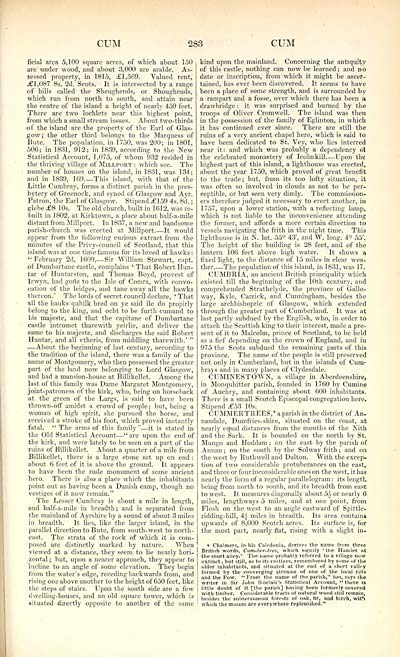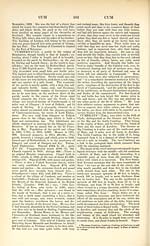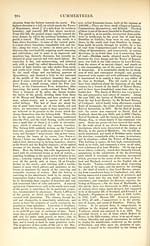Topographical, statistical, and historical gazetteer of Scotland > Volume 1
(365) Page 283
Download files
Complete book:
Individual page:
Thumbnail gallery: Grid view | List view

CUM
283
CUM
ficial area 5,100 square acres, of which about 150
are under wood, and about 3,000 are arable. As-
sessed property, in 1815, £1,569. Valued rent,
£1,087 8s. 2d. Scots. It is intersected by a range
of hills called the Sheughends, or Shoughends,
which run from north to south, and attain near
the centre of the island a height of nearly 450 feet.
There are two lochlets near this highest point,
from which a small stream issues. About two-thirds
of the island are the property of the Earl of Glas-
gow; the other third belongs to the Marquess of
Bute. The population, in 1750, was 200; in 1801,
506; in 1831, 912; in 1839, according to the New
Statistical Account, 1,075, of whom 932 resided in
the thriving village of Millport : which see. The
number of houses on the island, in 1831, was 134;
and in 1839, 169.— This island, with that of the
Little Cumbray, forms a distinct parish in the pres-
bytery of Greenock, and synod of Glasgow and Ayr.
Patron, the Earl of Glasgow. Stipend £159 4s. 8d. ;
glebe £8 10s. The old church, built in 1612, was re-
built in 1802, at Kirktown, a place about haif-a-mile
distant from Millport. In 1837, a new and handsome
parish-church was erected at Millport It would
appear from the following curious extract from the
minutes of the Privy-council of Scotland, that this
island was at one time famous for its breed of hawks :
" February 2d, 1609,— Sir William Stewart, capt.
of Dumbartane castle, complains ' That Robert Hun-
tar of Huntarston, and Thomas Boyd, provest of
Irwjm, had goile to the Isle of Comra, with convo-
cation of the leidges, and tane away all the hawks
thereon.' The lords of secret council declare, 'That
all the banks quhilk bred on ye said ile do propirly
belong to the king, and ocht to be furth cumand to
his majeste, and that the capitane of Dumbartane
castle intromet tharewith yeirlie, and deliver the
same to his majeste, and discharges the said Robert
Huntar, and all vtheris, from middling tharewith.' "
— About the beginning of last century, according to
the tradition of the island, there was a family of the
name of Montgomery, who then possessed the greater
part of the land now belonging to Lord Glasgow,
and had a mansion-house at Bilhkellet. Among the
last of this family was Dame Margaret Montgomery,
joint-patroness of the kirk, who, being on horseback
at the green of the Largs, is said to have been
thrown-off amidst a crowd of people ; but, being a
woman of high spirit, she pursued the horse, and
received a stroke of his foot, which proved instantly
fatal. ' ; The arms of this family ". — it is stated in
the Old Statistical Account — "are upon the end of
the kirk, and were lately to be seen on a part of the
ruins of Bilhkellet. About a quarter of a mile from
Billikellet, there is a large stone set up on end :
about 6 feet of it is above the ground. It appears
to have been the rude monument of some ancient
hero. There is also a place which the inhabitants
point out as having been a Danish camp, though no
vestiges of it now remain."
The Lesser Cumbray is about a mile in length,
and half-a-mile in breadth; and is separated from
the mainland of Ayrshire by a sound of about 3 miles
in breadth. It lies, like the larger island, in the
parallel direction to Bute, from south-west to north-
east. The strata of the rock of which it is com-
posed are distinctly marked by nature. When
viewed at a distance, they seem to lie nearly hori-
zontal ; but, upon a nearer approach, they appear to
incline to an angle of some elevation. They begin
from the water's edge, receding backwards from, and
rising one above another to the height of 650 feet, like
the steps of stairs. Upon the south side are a few
dwelling-houses, and an old square tower, which is
situated directly opposite to another of the same
kind upon the mainland. Concerning the antiquity
of this castle, nothing can no w be learned ; and no
date or inscription, from which it might be ascer-
tained, has ever been discovered. It seems to have
been a place of some strength, and is surrounded by
a rampart and a fosse, over which there has been a
drawbridge : it was surprised and burned by the
troops of Oliver Cromwell. The island was then
in the possession of the family of Eglinton, in which
it has continued ever since. There are still the
ruins of a very ancient chapel here, which is said to
have been dedicated to St. Vey, who lies interred
near it: and which was probably a dependency ol
the celebrated monastery of Icolmkill Upon the
highest part of this island, a lighthouse was erected,
about the year 1 750, which proved of great benefit
to the trade; but, from its too lofty situation, it
was often so involved in clouds as not to be per-
ceptible, or but seen very dimly. The commission-
ers therefore judged it necessary to erect another, in
1757, upon a lower station, with a reflecting lamp,
which is not liable to the inconvenience attending
the former, and affords a more certain direction to
vessels navigating the frith in the night time. This
lighthouse is in N. lat. 55° 43', and W. long. 4° 55'.
The height of the building is 28 feet, and of the
lantern 106 feet above high water. It shows a
fixed light, to the distance of 15 miles in clear wea-
ther The population of this island, in 1831, was 17.
CUMBRIA, an ancient British principality which
existed till the beginning of the 10th century, and
comprehended Strathclyde, the province of Gallo-
way, Kyle, Carrick, and Cunningham, besides the
large archbishopric of Glasgow, which extended
through the greater part of Cumberland. It was at
last partly subdued by the English, who, in order to
attach the Scottish king to their interest, made a pre-
sent of it to Malcolm, prince of Scotland, to be held
as a fief depending on the crown of England, and in
975 the Scots subdued the remaining parts of this
province. The name of the people is still preserved
not only in Cumberland, but in the islands of Cum-
brays and in many places of Clydesdale.
CUMINESTOWN, a village in Aberdeenshire,
in Monquhitter parish, founded in 1760 by Cumine
of Auchry, and containing about 600 inhabitants.
There is a small Scotch Episcopal congregation here.
Stipend £53 10s.
CUMMERTREES,* a parish in the district of An-
nandale, Dumfries-shire, situated on the coast, at
nearly equal distances from the mouths of the Kith
and the Sark. It is bounded on the north by St.
Mungo and Hoddam ; on the east by the parish of
Annan ; on the south by the Solway frith ; and on
the west by Ruthwell and Dalton. With the excep-
tion of two considerable protuberances on the east,
and three or four inconsiderable ones on the west, it has
nearly the form of a regular parallelogram : its length
being from north to south, and its breadth from east
to west. It measures diagonally about 5^ or nearly 6
miles, lengthways 5 miles, and at one point, from
Flosh on the west to an angle eastward of Spittle-
ridding-hill, 4± miles in breadth. Its area contains
upwards of 8,000 Scotch acres. Its surface is, for
the most part, nearly flat, rising with a slight in-
* Chalmers, in his Caledonia, derives the name from three
I British words, Cutruber-tres, which signify 'the Hamlet at
the short alley. 1 The name probably referred to a village now
extinct ; but still, as to its vestiges, remembered by some of the
older inhabitants, aud situated at the end of a short valley
formed by the converging streams of one of the local rills
and the Pow. " From the name of the parish," too, says the
writer in Sir John Sinclair's Statistical Account, "there is
little doubt of it [the parish] having been formerly covered
with timber. Considerable tracts ot natural wood still remain,
besides the Bubterannean forests of oak, fir, and birch, with
which the mosses are everywhere replenished."
283
CUM
ficial area 5,100 square acres, of which about 150
are under wood, and about 3,000 are arable. As-
sessed property, in 1815, £1,569. Valued rent,
£1,087 8s. 2d. Scots. It is intersected by a range
of hills called the Sheughends, or Shoughends,
which run from north to south, and attain near
the centre of the island a height of nearly 450 feet.
There are two lochlets near this highest point,
from which a small stream issues. About two-thirds
of the island are the property of the Earl of Glas-
gow; the other third belongs to the Marquess of
Bute. The population, in 1750, was 200; in 1801,
506; in 1831, 912; in 1839, according to the New
Statistical Account, 1,075, of whom 932 resided in
the thriving village of Millport : which see. The
number of houses on the island, in 1831, was 134;
and in 1839, 169.— This island, with that of the
Little Cumbray, forms a distinct parish in the pres-
bytery of Greenock, and synod of Glasgow and Ayr.
Patron, the Earl of Glasgow. Stipend £159 4s. 8d. ;
glebe £8 10s. The old church, built in 1612, was re-
built in 1802, at Kirktown, a place about haif-a-mile
distant from Millport. In 1837, a new and handsome
parish-church was erected at Millport It would
appear from the following curious extract from the
minutes of the Privy-council of Scotland, that this
island was at one time famous for its breed of hawks :
" February 2d, 1609,— Sir William Stewart, capt.
of Dumbartane castle, complains ' That Robert Hun-
tar of Huntarston, and Thomas Boyd, provest of
Irwjm, had goile to the Isle of Comra, with convo-
cation of the leidges, and tane away all the hawks
thereon.' The lords of secret council declare, 'That
all the banks quhilk bred on ye said ile do propirly
belong to the king, and ocht to be furth cumand to
his majeste, and that the capitane of Dumbartane
castle intromet tharewith yeirlie, and deliver the
same to his majeste, and discharges the said Robert
Huntar, and all vtheris, from middling tharewith.' "
— About the beginning of last century, according to
the tradition of the island, there was a family of the
name of Montgomery, who then possessed the greater
part of the land now belonging to Lord Glasgow,
and had a mansion-house at Bilhkellet. Among the
last of this family was Dame Margaret Montgomery,
joint-patroness of the kirk, who, being on horseback
at the green of the Largs, is said to have been
thrown-off amidst a crowd of people ; but, being a
woman of high spirit, she pursued the horse, and
received a stroke of his foot, which proved instantly
fatal. ' ; The arms of this family ". — it is stated in
the Old Statistical Account — "are upon the end of
the kirk, and were lately to be seen on a part of the
ruins of Bilhkellet. About a quarter of a mile from
Billikellet, there is a large stone set up on end :
about 6 feet of it is above the ground. It appears
to have been the rude monument of some ancient
hero. There is also a place which the inhabitants
point out as having been a Danish camp, though no
vestiges of it now remain."
The Lesser Cumbray is about a mile in length,
and half-a-mile in breadth; and is separated from
the mainland of Ayrshire by a sound of about 3 miles
in breadth. It lies, like the larger island, in the
parallel direction to Bute, from south-west to north-
east. The strata of the rock of which it is com-
posed are distinctly marked by nature. When
viewed at a distance, they seem to lie nearly hori-
zontal ; but, upon a nearer approach, they appear to
incline to an angle of some elevation. They begin
from the water's edge, receding backwards from, and
rising one above another to the height of 650 feet, like
the steps of stairs. Upon the south side are a few
dwelling-houses, and an old square tower, which is
situated directly opposite to another of the same
kind upon the mainland. Concerning the antiquity
of this castle, nothing can no w be learned ; and no
date or inscription, from which it might be ascer-
tained, has ever been discovered. It seems to have
been a place of some strength, and is surrounded by
a rampart and a fosse, over which there has been a
drawbridge : it was surprised and burned by the
troops of Oliver Cromwell. The island was then
in the possession of the family of Eglinton, in which
it has continued ever since. There are still the
ruins of a very ancient chapel here, which is said to
have been dedicated to St. Vey, who lies interred
near it: and which was probably a dependency ol
the celebrated monastery of Icolmkill Upon the
highest part of this island, a lighthouse was erected,
about the year 1 750, which proved of great benefit
to the trade; but, from its too lofty situation, it
was often so involved in clouds as not to be per-
ceptible, or but seen very dimly. The commission-
ers therefore judged it necessary to erect another, in
1757, upon a lower station, with a reflecting lamp,
which is not liable to the inconvenience attending
the former, and affords a more certain direction to
vessels navigating the frith in the night time. This
lighthouse is in N. lat. 55° 43', and W. long. 4° 55'.
The height of the building is 28 feet, and of the
lantern 106 feet above high water. It shows a
fixed light, to the distance of 15 miles in clear wea-
ther The population of this island, in 1831, was 17.
CUMBRIA, an ancient British principality which
existed till the beginning of the 10th century, and
comprehended Strathclyde, the province of Gallo-
way, Kyle, Carrick, and Cunningham, besides the
large archbishopric of Glasgow, which extended
through the greater part of Cumberland. It was at
last partly subdued by the English, who, in order to
attach the Scottish king to their interest, made a pre-
sent of it to Malcolm, prince of Scotland, to be held
as a fief depending on the crown of England, and in
975 the Scots subdued the remaining parts of this
province. The name of the people is still preserved
not only in Cumberland, but in the islands of Cum-
brays and in many places of Clydesdale.
CUMINESTOWN, a village in Aberdeenshire,
in Monquhitter parish, founded in 1760 by Cumine
of Auchry, and containing about 600 inhabitants.
There is a small Scotch Episcopal congregation here.
Stipend £53 10s.
CUMMERTREES,* a parish in the district of An-
nandale, Dumfries-shire, situated on the coast, at
nearly equal distances from the mouths of the Kith
and the Sark. It is bounded on the north by St.
Mungo and Hoddam ; on the east by the parish of
Annan ; on the south by the Solway frith ; and on
the west by Ruthwell and Dalton. With the excep-
tion of two considerable protuberances on the east,
and three or four inconsiderable ones on the west, it has
nearly the form of a regular parallelogram : its length
being from north to south, and its breadth from east
to west. It measures diagonally about 5^ or nearly 6
miles, lengthways 5 miles, and at one point, from
Flosh on the west to an angle eastward of Spittle-
ridding-hill, 4± miles in breadth. Its area contains
upwards of 8,000 Scotch acres. Its surface is, for
the most part, nearly flat, rising with a slight in-
* Chalmers, in his Caledonia, derives the name from three
I British words, Cutruber-tres, which signify 'the Hamlet at
the short alley. 1 The name probably referred to a village now
extinct ; but still, as to its vestiges, remembered by some of the
older inhabitants, aud situated at the end of a short valley
formed by the converging streams of one of the local rills
and the Pow. " From the name of the parish," too, says the
writer in Sir John Sinclair's Statistical Account, "there is
little doubt of it [the parish] having been formerly covered
with timber. Considerable tracts ot natural wood still remain,
besides the Bubterannean forests of oak, fir, and birch, with
which the mosses are everywhere replenished."
Set display mode to: Large image | Transcription
Images and transcriptions on this page, including medium image downloads, may be used under the Creative Commons Attribution 4.0 International Licence unless otherwise stated. ![]()
| Gazetteers of Scotland, 1803-1901 > Topographical, statistical, and historical gazetteer of Scotland > Volume 1 > (365) Page 283 |
|---|
| Permanent URL | https://digital.nls.uk/97441926 |
|---|
| Description | Volume first. A-H. |
|---|---|
| Attribution and copyright: |
|

